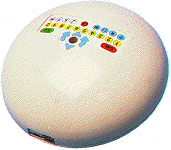
|
Feedback Form

A ROAMER IN SPACE

The National Mobility Centre in Birmingham has been using the Roamer to help visually impaired children understand space. The following piece is an extract from an article by Penny Gay, a Peripatetic Support Teacher for the Cornwall Advisory Service for Visually Impaired Children. It is published in full in the British Journal of Visual Impairment.
Amy is a bright, talkative four-year old who is totally blind. She spent three mornings at the RCEVH (Research Centre for the Education of the Visually Handicapped). The Roamer was given two eyes, a nose and tail and soon became Amy's "little friend". Her teacher first made a tactile replica of the keyboard drawn with a raised line on German film. This proved confusing, so the keyboard was redesigned with X-ray film as a base. Matchsticks were placed in a cross over the penhole, pointing to the four arrows, sponge was placed over the Cancel Memory key (which Amy called the "Clear Mind" key). Ten small buttons were placed over the numbers, a tactually distinct button over the sound key and a piece of Velcro over the GO key.

Initially the teacher controlled the keyboard and Amy followed the Roamer by tracking the sound or feeling it move with her hands.
"She knew 'Forwards', 'Backwards' and 'Spinning' or 'Turning'. She could also tell whether the Roamer was facing her or had its back to her. She knew 'side', but was not sure of left and right, though she knew her own left and right hands.
Amy needed much physical prompting and verbal reinforcement before she
started pressing the keys. She was encouraged to move her body in the
way she wanted the Roamer to move, for example, walking forward 3 paces
before pressing  . Finding the
correct keys to press also required spatial language and understanding.
Amy had to learn that Forward was 'at the top' or 'in front of' the matchstick
cross. The numeric buttons had to be counted from left to right.
. Finding the
correct keys to press also required spatial language and understanding.
Amy had to learn that Forward was 'at the top' or 'in front of' the matchstick
cross. The numeric buttons had to be counted from left to right.
In her excitement Amy sometimes pressed the keys in the wrong order. She also went through periods of trying to control the Roamer by speaking to it. When the teacher said, "Tell the Roamer to go forwards," she would take the instruction literally, give the Roamer a push and say, "Go forwards, little friend". After three sessions she could enter an instruction when a verbal prompt was given for each key. She found it helpful and satisfying to hear the 'bleep' whenever a correct key was pressed.
The Roamer retains its most recent command in its memory and carries it out when the GO key is pressed. Amy used this feature to make the Roamer travel the length of the corridor. She walked behind it crying, "Straight ahead! Straight ahead!" then, "It still hasn't got there". When the Roamer bumped into the wall Amy "put him straight". Her teacher was pleased to see Amy walk in the middle of the corridor when following the Roamer, as she usually trailed the walls.
Amy's teacher devised a game called "Where is Roamer?" She placed the Roamer somewhere in the room and programmed it to play a tune. Amy enjoyed finding it. The Roamer was then programmed to move in a triangle or square around Amy. Amy tracked the sound, faced and pointed to where it was going. Finally Amy sat on the floor while the Roamer played a tune, then said where it was, "In front of me. Behind me," or "To the side". She was not always sure if it was right or left, but had begun to learn.
Although the project is still in an early stage Amy's teacher, Perry Gay, made the following evaluation:
- A blind four-year old maintained interest and enjoyment in the Roamer for short periods over several weeks.
- With only a verbal prompt she could find the keys to give a simple command.
- Many important spatial concepts were used in active learning.
- The Roamer encouraged use of spatial language linked to first-hand sensory experience.
- The auditory feedback was useful in many sound location and tracking tasks.
Training in orientation skills has long been recommended for blind children and programming the Roamer can help reinforce this in an enjoyable way.
| Back |
|---|